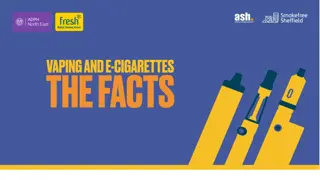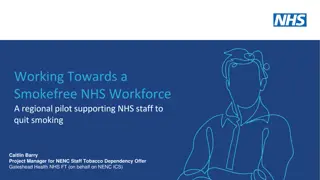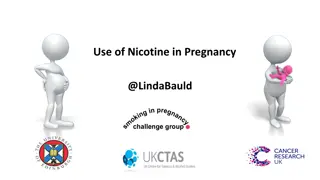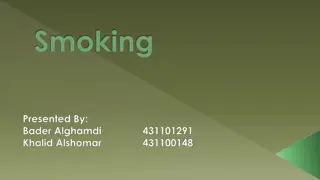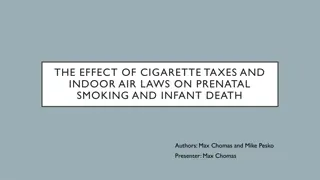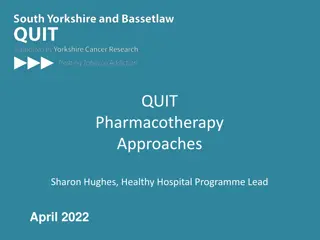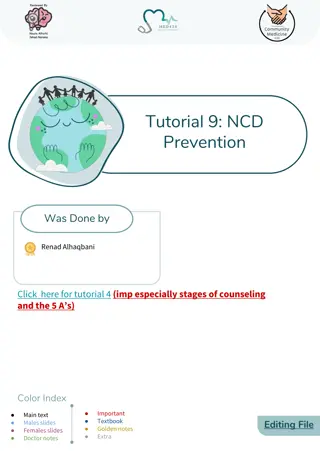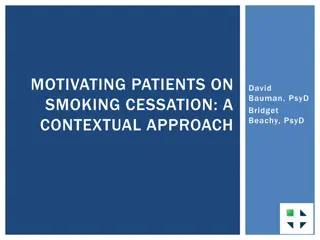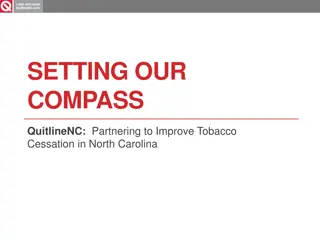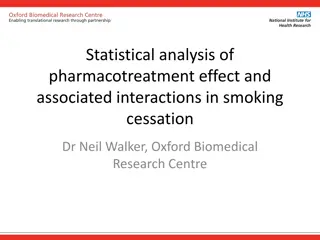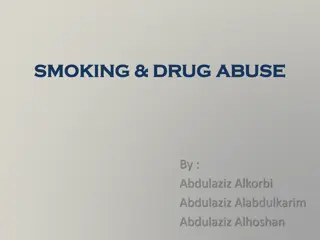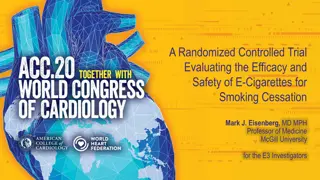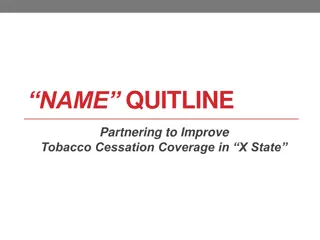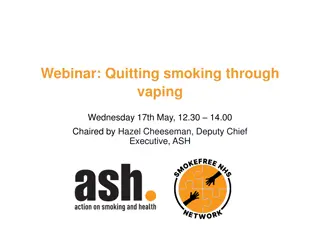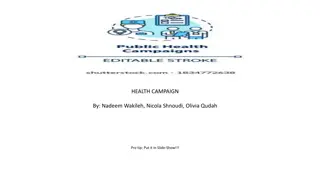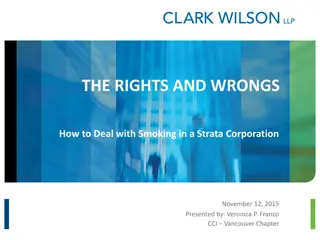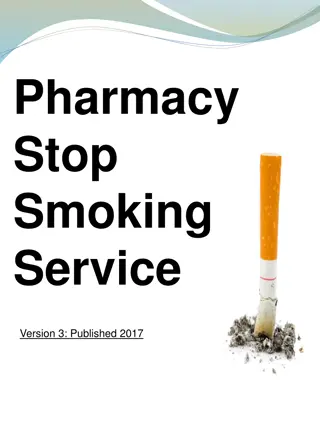Family Physician Education and Barriers to Promoting Smoking Cessation Investigation
This multi-service investigation explores formal smoking cessation education in Family Medicine residency programs and ongoing education for Family Physicians within the military healthcare system. It aims to identify barriers to providing smoking cessation tools and resources and assess the incorporation of LCS recommended by the USPSTF.
Download Presentation

Please find below an Image/Link to download the presentation.
The content on the website is provided AS IS for your information and personal use only. It may not be sold, licensed, or shared on other websites without obtaining consent from the author.If you encounter any issues during the download, it is possible that the publisher has removed the file from their server.
You are allowed to download the files provided on this website for personal or commercial use, subject to the condition that they are used lawfully. All files are the property of their respective owners.
The content on the website is provided AS IS for your information and personal use only. It may not be sold, licensed, or shared on other websites without obtaining consent from the author.
E N D
Presentation Transcript
FAMILY PHYSICIAN EDUCATION AND BARRIERS TO PROMOTING SMOKING CESSATION: A MULTI-SERVICE INVESTIGATION Kryls Domalaon, MD Travis Family Medicine Residency 60thMDG/HCOS, Travis AFB, CA Christina Valerio, MD Travis Family Medicine Residency 60thMDG/HCOS, Travis AFB, CA
Disclosure The views and statements in the presentation are solely from the investigators. They do not represent the opinions or positions of the Department of Defense or the United States Air Force. The investigators have no financial disclosures.
Background SIGNIFICANCE Cigarette smoking is the LEADING CAUSE of preventable disease and death in the US 1 in every 5 people use tobacco products
Background 5 A s of Smoking Cessation SIGNIFICANCE ASK ARRANGE ADVISE ASSIST ASSESS
Objectives AIM 1. Describe the amount of formal smoking cessation education offered by Family Medicine residency programs. AIM 2. Assess the amount of ongoing education about smoking cessation provided within the military healthcare system to Family Physicians. AIM 3. Assess what barriers exist to providing recommended smoking cessation tools and resources within the military healthcare system. AIM 4. Assess if military family physicians incorporate LCS as recommended by the USPSTF with smoking cessation education and resources.
Design & Methods Cross-sectional study Study Population: 2022 USAFP Annual Conference attendees Statistical Analysis: descriptive statistics with chi-square analysis
Demographics GENDER n = RACE n = BRANCH OF SERVICE n = Female 121 White 206 Air Force 98 Male 146 Asian/Pacific Islander 29 Army 112 Other 1 Black/African American 8 Navy 72 Prefer not to answer 7 Hispanic, Latin-X 9 Coast Guard 6 Other 2 Public Health Service 2 Prefer not to answer 10 Retired/Former Service 22 Multiple race 9 Civilian (no military service) 9 N = 321
Demographics GENDER n = RACE n = BRANCH OF SERVICE n = Female 121 Air Force 98 White 206 Asian/Pacific Islander 29 Male 146 Army 112 Other 1 Black/African American 8 Navy 72 Prefer not to answer 7 Hispanic, Latin-X 9 Coast Guard 6 Other 2 Public Health Service 2 Prefer not to answer 10 Retired/Former Service 22 Multiple race 9 Civilian (no military service) 9 N = 321
Demographics TIME IN CLINICAL PRACTICE n = TYPE OF PRACTICE* n = 25% 81 Academic 166 25% - 50% 47 Outpatient - Active Duty 147 51% - 75% 42 Outpatient Dependents & Retirees 99 > 75% 103 Emergency Department 28 Inpatient 74 OB 65 N = 321 *Respondents were able to choose multiple practice types
Demographics TIME IN CLINICAL PRACTICE n = TYPE OF PRACTICE* n = 25% 81 Academic 166 25% - 50% 47 Outpatient - Active Duty 147 51% - 75% 42 Outpatient Dependents & Retirees 99 Emergency Department 28 > 75% 103 Inpatient 74 OB 65 N = 321 *Respondents were able to choose multiple practice types
Survey Questions o During your residency training, approximately how many hours of formal education on smoking cessation were offered? None Limited A few (2-3) sessions >3 sessions
Survey Questions o How often has your MTF or healthcare system offered guidance on smoking cessation resources, tools and education? Never Rarely Sometimes Frequently
Survey Questions o Please select any barriers you encounter in providing smoking cessation counseling, education and resources to patients. Time Education Comfort Lack of prompt from EMR Efficacy Lack of support staff Other
Results Response Rate = 61%
Results Q1 by Time Since Residency. During residency, how much formal education about smoking cessation do you remember? Q1 0-3 Years 4-7 Years 8-11 Years >11 Years None 3.7 1.8 2.4 1.4 Limited 15.9 23.6 11.9 6.8 A few (2-3) sessions 40.2 49.1 50.0 29.7 > 3 sessions 12.2 14.6 21.4 44.6 Missing 28.1 10.9 14.3 17.6
Results Q1 by Time Since Residency. During residency, how much formal education about smoking cessation do you remember? Q1 0-3 Years 4-7 Years 8-11 Years >11 Years None 3.7 1.8 2.4 1.4 Limited 15.9 23.6 11.9 6.8 A few (2-3) sessions 40.2 49.1 50.0 29.7 > 3 sessions 44.6 12.2 14.6 21.4 Missing 28.1 10.9 14.3 17.6
Results Q2 by Practice. After residency, how much education about smoking cessation have you received? Outpatient Active Duty Outpatient Dependent/Retiree Q2 Emergency Inpatient OB Academic None 10.2 11.1 14.3 12.2 13.9 15.7 Limited 25.2 21.2 10.7 18.9 13.9 18.7 Moderate (2-3 hrs) 17.7 18.2 14.3 16.2 15.4 19.3 > 3 hrs 19.7 17.2 14.3 13.5 16.9 14.5 Missing 27.2 32.3 46.4 39.2 40.0 31.9
Results Q2 by Practice. After residency, how much education about smoking cessation have you received? Outpatient Active Duty Outpatient Dependent/Retiree Q2 Emergency Inpatient OB Academic None 14.3 10.2 11.1 12.2 13.9 15.7 Limited 25.2 21.2 18.9 10.7 13.9 18.7 Moderate (2-3 hrs) 14.3 19.3 17.7 18.2 16.2 15.4 > 3 hrs 14.3 16.9 19.7 17.2 13.5 14.5 Missing 27.2 32.3 46.4 39.2 40.0 31.9
Results Q3 by Branch of Service. How often does your healthcare system or MTF provide you with resources, tools or education focused on smoking cessation? Retired/Prior Service Civilian w/o Prior Service Q3 Air Force Army Coast Guard Navy PHS Never 3.1 8.9 0 12.5 0 0 0 Rarely 33.7 32.1 16.7 22.2 0 31.8 33.3 Sometimes 35.7 28.6 0 23.6 0 22.7 0 Frequently 10.2 8.9 33.3 16.7 50.0 27.3 0 Missing 17.4 21.4 50.0 25.0 50.0 18.2 66.7
Results Q3 by Branch of Service. How often does your healthcare system or MTF provide you with resources, tools or education focused on smoking cessation? Retired/Prior Service Civilian w/o Prior Service Q3 Air Force Army Coast Guard Navy PHS Never 3.1 8.9 0 12.5 0 0 0 32.1 31.8 33.3 Rarely 33.7 16.7 22.2 0 35.7 23.6 Sometimes 28.6 0 0 22.7 0 33.3 50.0 Frequently 10.2 8.9 16.7 27.3 0 Missing 17.4 21.4 50.0 25.0 50.0 18.2 66.7
Results Q5 by Practice. When ordering annual lung cancer screening for an active smoker, how often do you counsel about smoking cessation? Outpatient Active Duty Outpatient Dependent/Retiree Q5 Emergency Inpatient OB Academic Never 1.4 1.0 0 0 0 0 Rarely 0.7 2.0 0 2.7 1.5 1.8 Sometimes 8.2 4.0 3.6 4.1 3.1 6.0 Usually 25.9 29.3 32.1 32.4 33.9 34.9 Always 42.2 42.4 35.7 36.5 36.9 38.6 Missing 21.8 21.2 28.6 24.3 24.6 18.7
Results Q5 by Practice. When ordering annual lung cancer screening for an active smoker, how often do you counsel about smoking cessation? Outpatient Active Duty Outpatient Dependent/Retiree Q5 Emergency Inpatient OB Academic Never 1.4 1.0 0 0 0 0 Rarely 0.7 2.0 0 2.7 1.5 1.8 Sometimes 8.2 4.0 3.6 4.1 3.1 6.0 Usually 25.9 29.3 32.1 32.4 33.9 34.9 Always 42.2 42.4 35.7 36.5 36.9 38.6 Missing 21.8 21.2 28.6 24.3 24.6 18.7
Results Barriers to Pairing Smoking Cessation Counseling and LCS Q4 & Q6 Barriers to Promoting Smoking Cessation Time 201 (62.6) 182 (56.7) Education 26 (8.1) 10 (3.1) Comfort 21 (6.5) 7 (2.2) No EMR Prompt 42 (13.1) 19 (5.9) Lack of Efficacy 26 (8.1) 21 (6.5) Lack of Staff 110 (34.3) 56 (17.5)
Results Barriers to Pairing Smoking Cessation Counseling and LCS Q4 & Q6 Barriers to Promoting Smoking Cessation Time 201 (62.6%) 182 (56.7%) Education 26 (8.1) 10 (3.1) Comfort 21 (6.5) 7 (2.2) No EMR Prompt 42 (13.1) 19 (5.9) Lack of Efficacy 26 (8.1) 21 (6.5) Lack of Staff 110 (34.3) 56 (17.5)
Results Barriers to Pairing Smoking Cessation Counseling and LCS Q4 & Q6 Barriers to Promoting Smoking Cessation Time 201 (62.6%) 182 (56.7%) Education 26 (8.1) 10 (3.1) Comfort 21 (6.5) 7 (2.2) No EMR Prompt 42 (13.1) 19 (5.9) Lack of Efficacy 26 (8.1) 21 (6.5) Lack of Staff 110 (34.3%) 56 (17.5%)
Discussion The amount of formal education during residency did NOT change the likelihood of integrating LCS with smoking cessation counseling. 48% reported their healthcare system NEVER or RARELY provided resources, tools or education on smoking cessation Only 50.6% overall and 22-50% when stratified by branch of service ALWAYS paired LCS with smoking cessation counseling
Conclusion Smoking cessation education was reported to be RARELY offered after residency. Many physicians do NOT consistently link LCS guidelines with patient education on tobacco cessation and resources. Largest Barriers Time Lack of support staff
References Cornelius ME, Wang TW, Jamal A, Loretan CG, Neff LJ. Tobacco Product Use Among Adults - United States, 2019. MMWR Morb Mortal Wkly Rep. 2020 Nov 20;69(46):1736-1742. doi: 10.15585/mmwr.mm6946a4. PMID: 33211681; PMCID: PMC7676638. Zwar NA, Mendelsohn CP, Richmond RL. Supporting Smoking Cessation. BMJ. 2014 Jan 14;348:f7535. doi: 10.1136/bmj.f7535. PMID: 24423971. Patel MS, Steinberg MB. In the Clinic. Smoking Cessation. Ann Intern Med. 2016 Mar 1;164(5):ITC33-ITC48. doi: 10.7326/AITC201603010. PMID: 26926702. Lung cancer: Screening. US Preventive Services Taskforce. https://www.uspreventiveservicestaskforce.org/uspstf/document/evidence- summary14/lung-cancer-screening. Published March 9, 2021. Accessed January 14, 2023. Fucito LM, Czabafy S, Hendricks PS, et al. Pairing smoking-cessation services with lung cancer screening: A clinical guideline from the Association for the Treatment of Tobacco Use and Dependence and the Society for Research on Nicotine and Tobacco. Cancer. 2016;122(8):1150-1159. doi:10.1002/cncr.29926. Centers for Medicare and Medicaid Services. Decision Memo for Screening for Lung Cancer with Low Dose Computed Tomography (LDCT) (CAG-00439N). Baltimore, MD: Centers for Medicare and Medicaid Services; 2014.
References Kathuria H, Koppelman E, Borrelli B, et al. Patient-Physician Discussions on Lung Cancer Screening: A Missed Teachable Moment to Promote Smoking Cessation. Nicotine Tob Res. 2020;22(3):431-439. doi:10.1093/ntr/nty254. Current cigarette smoking among adults in the United States. Centers for Disease Control and Prevention. https://www.cdc.gov/tobacco/data_statistics/fact_sheets/adult_data/cig_smoking/index.ht m. Published March 17, 2022. Accessed January 14, 2023. Who report on the global tobacco epidemic, 2011: Warning about the dangers of tobacco. World Health Organization. https://apps.who.int/iris/handle/10665/44616. Published January 1, 1970. Accessed January 14, 2023. Boyle R, Solberg LI. Is making smoking status a vital sign sufficient to increase cessation support actions in clinical practice? Ann Fam Med. 2004;2(1):22-25. doi:10.1370/afm.38 2018 Military Demographics Profile. Military OneSource. https://www.militaryonesource.mil/data-research-and-statistics/military-community- demographics/2018-demographics-profile/. Published November 29, 2022. Accessed January 15, 2023.
References Office USGA. Military personnel: Additional actions needed to address gaps in military physician specialties. Military Personnel: Additional Actions Needed to Address Gaps in Military Physician Specialties | U.S. GAO. https://www.gao.gov/products/gao-18-77. Published February 28, 2018. Accessed January 15, 2023. Office USGA. Coast Guard Health Care: Improvements needed for determining staffing needs and monitoring access to care. Coast Guard Health Care: Improvements Needed for Determining Staffing Needs and Monitoring Access to Care | U.S. GAO. https://www.gao.gov/products/gao-22-105152. Published February 4, 2022. Accessed January 15, 2023. Gaddey HL, Dakkak M, Jackson NM. Smoking Cessation Interventions. Am Fam Physician. 2022;106(5):513-522. Mazzone P, Powell CA, Arenberg D, et al. Components necessary for high-quality lung cancer screening: American College of Chest Physicians and American Thoracic Society Policy Statement. Chest. 2015;147(2):295-303. doi:10.1378/chest.14-2500 Kim J, Lee H, Huang BW. Lung Cancer: Diagnosis, Treatment Principles, and Screening. Am Fam Physician. 2022;105(5):487-494.
Q & A kryls.o.domalaon.mil@health.mil


